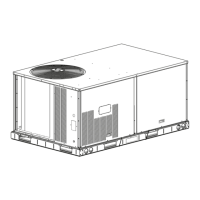13
Fig. 19 — Typical Piping Schematic
THERMOSTATIC EXPANSION VALVE (TXV)
All 50GCQ units have a factory-installed nonadjustable thermo-
static expansion valve (TXV). The TXV is a bi-flow, bleed port
expansion valve with an external equalizer. The TXVs are specifi-
cally designed to operate with Puron
®
(R-410A) refrigerant. Use
only factory-authorized TXVs.
TXV Operation
The TXV is a metering device that is used in air conditioning and
heat pump systems to adjust to the changing load conditions by
maintaining a preset superheat temperature at the outlet of the
evaporator coil.
The volume of refrigerant metered through the valve seat is
dependent upon the following:
1. Superheat temperature is sensed by cap tube sensing bulb
on suction tube at outlet of evaporator coil. This tempera-
ture is converted into pressure by refrigerant in the bulb
pushing downward on the diaphragm, which opens the
valve using the push rods.
2. The suction pressure at the outlet of the evaporator coil is
transferred through the external equalizer tube to the
underside of the diaphragm.
3. The pin is spring loaded, which exerts pressure on the
underside of the diaphragm. Therefore, the bulb pressure
works against the spring pressure and evaporator suction
pressure to open the valve. If the load increases, the tem-
perature increases at the bulb, which increases the pressure
on the top side of the diaphragm. This opens the valve and
increases the flow of refrigerant. The increased refrigerant
flow causes the leaving evaporator temperature to
decrease. This lowers the pressure on the diaphragm and
closes the pin. The refrigerant flow is effectively stabilized
to the load demand with negligible change in superheat.
Replacing TXV
1. Recover refrigerant.
2. Remove TXV support clamp using a 5/l6 in. nut driver.
3. Remove TXV using a wrench and an additional wrench on
connections to prevent damage to tubing.
4. Remove equalizer tube from suction line of coil. Use file
or tubing cutter to cut brazed equalizer line approximately
2 inches above suction tube.
5. Remove bulb from vapor tube inside cabinet.
6. Install the new TXV using a wrench and an additional
wrench on connections to prevent damage to tubing while
attaching TXV to distributor.
7. Attach the equalizer tube to the suction line. If the coil has
a mechanical connection, then use a wrench and an addi-
tional wrench on connections to prevent damage. If the
coil has a brazed connection, use a file or a tubing cutter to
remove the mechanical flare nut from the equalizer line.
Then use a new coupling to braze the equalizer line to the
stub (previous equalizer line) in suction line.
8. Attach TXV bulb in the same location where the original
(in the sensing bulb indent) was when it was removed,
using the supplied bulb clamps. See Fig. 20.
9. Route equalizer tube through suction connection opening
(large hole) in fitting panel and install fitting panel in place.
10. Sweat the inlet of TXV marked “IN” to the liquid line. Avoid
excessive heat which could damage the TXV valve. Use
quenching cloth when applying heat anywhere on TXV.
B
Acutrol
DFT 1
Cooling Liquid Line
A
D
Outdoor Coil
Indoor Coil
C
Heating Mode Liquid Line
Strainer
Filter
Drier
LPS/LOC
Accurater
TXV
COMPRESSOR
ACCUMULATOR
HPS

